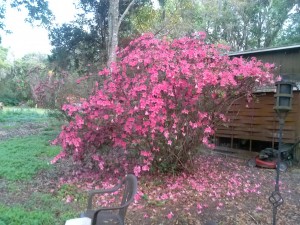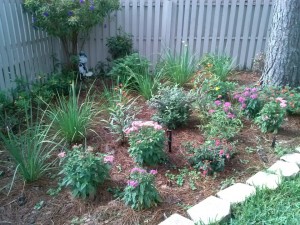When we have a mild winter season, it is easy to add winter color to your Tampa landscape, as most of the plants that are blooming all summer will continue to bloom throughout the winter. Plants that are year-around bloomers, such as Bougainvillea, Hibiscus, Plumbago, Dwarf Firebush, Oleander, Ixora and most butterfly perennials will endlessly bloom if the temperatures are above 50 degrees and the sun is shinning. As well, variegated leaf plants such as Croton, Shell Ginger, and Variegated Arboricola will continue to provide vivid color through their leaf patterns, no matter the weather conditions. Unfortunately, though, our winters are rarely mild, and all of these plants are prone to frost and freeze damage or die-back.
The truth is, most plants that provide year-around color through either blooms or foliage are generally not cold hardy. It can be risky to build an entire landscape on plants that can be damaged, or even killed, in any given winter. While these plants have their place in a garden, they will never be a fair substitute for the real show stoppers that add true winter color to your Tampa landscape: cool season annuals and cold hardy flowering landscape plants.
Annuals are plants that last for a season, although they can sometimes last longer. Most annuals have a preferred season to grow in, and are replaced out when the season passes. Some examples of annuals rotation that we use at Johns Palms Landscaping are Begonias in the spring, as they love the dry, hot weather, but hate the rains; Coleus prefers the summer, as it loves both the heat and the rainy season, but is prone to cold damage; and finally, the winter annuals, of which there is a nice selection to choose from. A good winter annual can handle both mild and extreme winters, as well as our moderate, but typical winter rainfall. In some cases, extreme frost or freeze may damage the flower, but not the plant itself, and within days, it will be blooming again. The winter annuals that we generally use are Geranium, Petunia, and Pansy, as they are characteristically the least fussy, and last the longest. Just remember, annuals should always be planted in a bed of well-draining potting soil, and when temperatures start to reach 85 degrees on a regular basis, it will be time to replace them out with spring annuals.
Seasonal annuals are not for everyone, and can have a moderate level of maintenance, given the chore of rotational replacements. Luckily, though, we have a handful of cold hardy landscape plants to choose from, that will add winter color to your Tampa landscape through flowers, that perfectly bloom this time of year, year after year. These little landscape gems will usually bloom late winter or early spring, depending upon how cold it is, and when the cold weather finally arrives. No matter when the blooms arrive, though, you can count on them being a winter surprise, just when everything else seems so drab and dull.
To add some winter color to your Tampa landscape, consider any of these awesome landscape plants:
- Azaleas, many varieties to choose from
- Brunfelsia
- Spirea
- Camellia, many varieties to choose from
- Daylily, many varieties to choose from
- Carolina Yellow Jasmine
- Cassia
- Tabebuia
While all of these plants have different needs, soil conditions, and preferred growing sites, if your landscape plan and maintenance efforts can meet their specific needs, you will be rewarded in abundance, not only with beautiful flowers but the gentle reminder that the rebirth of spring is drawing near. And, that is reason enough to add winter color to your Tampa landscape.


